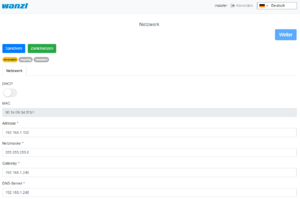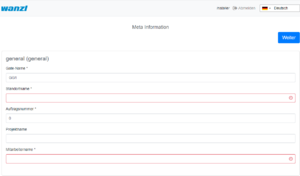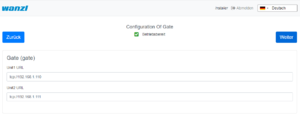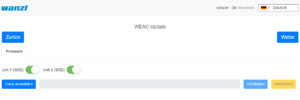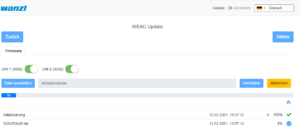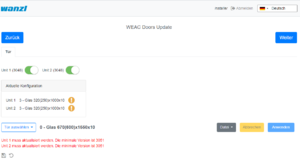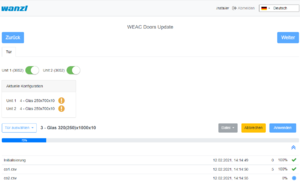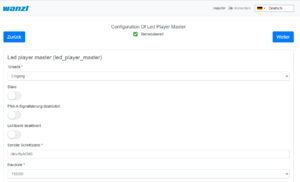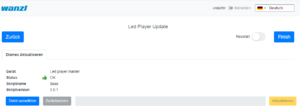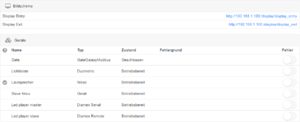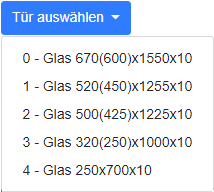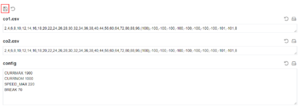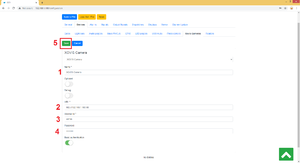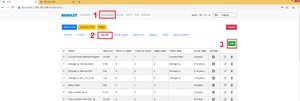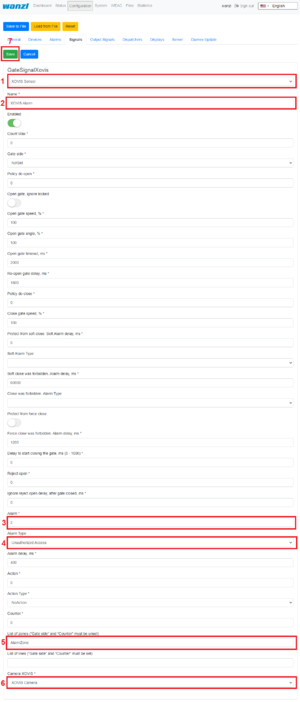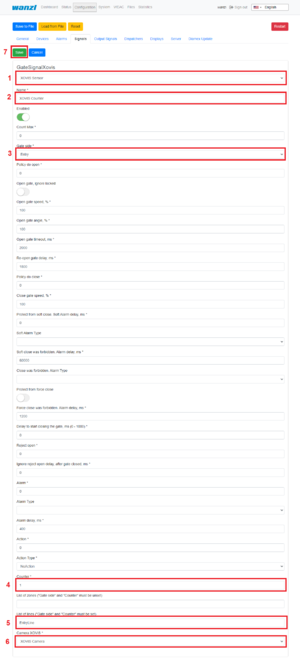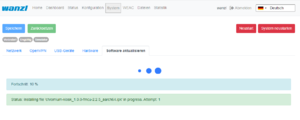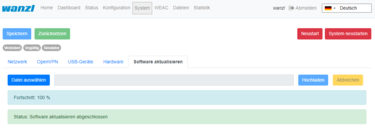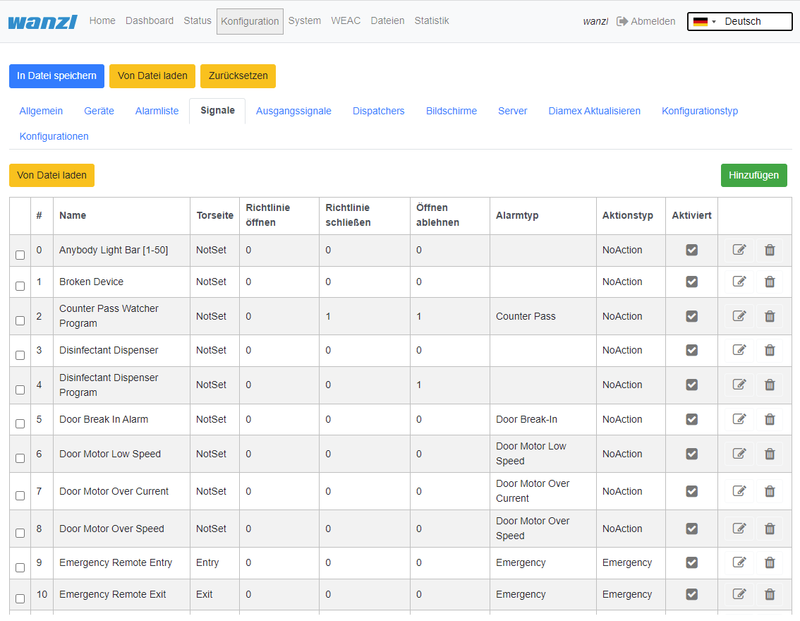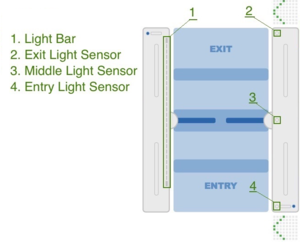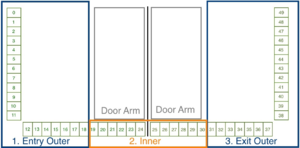Gate ~ FMCU ~ Benutzerhandbuch/en: Unterschied zwischen den Versionen
← Gate ~ FMCU ~ Benutzerhandbuch/en
(→Konfiguration des XOVIS Sensors) (Markierung: 2017-Quelltext-Bearbeitung) |
(→VPN-Schlüssel hinterlegen) (Markierung: 2017-Quelltext-Bearbeitung) |
Inhaltsverzeichnis
Introduction[Bearbeiten | Quelltext bearbeiten]
The document describes the functions and configuration options of the software Facility Management Control Unit.
The Facility Management Control Unit is software for access control management. It can be used in an enclosed area such as a sports or entertainment center, an airport zone, universities or security areas. The main components of the software solution are:
- An automated passage control with two-part door and signal lighting
- Barcode (or/and RFID) scanners that read identification data from the customer's ticket or card
- Tracking cameras observing the passage of customers
- Info screens showing inbound and outbound information to the customer
- One or more external speakers
- One or more additional monitors with content tailored to customer needs
The main features are:
- Opening access control upon successful ticket validation
-
Interaction with customer in response to various events through:
- Light effects
- Voice prompts through internal or external speakers
- Acoustic confirmation of the reading process from barcode scanners
- Visual content displayed on an info screen
- Safe opening and closing of the swing doors by monitoring the passage area
Supported operating modes:
- Normal
- Service
- Fire alarm
- Emergency
The variants of Entry Tickets:
- Single entry ticket with closing of access control after passage of one person
- Multiple entry ticket with permanent access control
- Adjustable time intervals
- Consideration of additional conditions about potential-free contacts
Technical Information[Bearbeiten | Quelltext bearbeiten]
Configuration[Bearbeiten | Quelltext bearbeiten]
Step 1
After the software has been downloaded and transferred to the eMMC card according to the documented procedure, see also here Galaxy Gate Inbetriebnahme, the login screen appears after the first start. After logging in with the user Installer, the wizard with the definition of the IP configuration is started.| Parameter | Description | Default Value |
|---|---|---|
| Address | IP-Address of access control | 192.168.1.100 |
| Mask | Network-Mask | 255.255.255.0 |
| Gateway | Gateway-Address | 192.168.1.1 |
| DNS-Server | DNS-Server for name resolution | 192.168.1.1 |
As a type, you can basically make this selection in the assistant.
| Selection | Description |
|---|---|
| No Device Slave | Slave Unit (Default Selection) |
| Galaxy Gate (Modbus Serial) | Master-Unit mit serieller Verbindung zu Slave-Unit |
| Galaxy Gate (Modbus TCP) | Master-Unit with network connection to Slave-Unit |
| Galaxy Port (Modbus Serial) | Unit with serial connection to Slave-Unit |
| Galaxy Port (Modbus TCP) | Unit with network connection to Slave-Unit |
| Function | Description |
|---|---|
| AEA | Configuration for Boarding Gates |
| Immediate Closure | Closing the swivel arms without swivel range monitoring |
| Multiple Opening | Swivel arms remain open when multiple input signals are present |
| Personal Protection | Closing the swivel arms with swivel area monitoring |
| One-time opening | Single pass even when several input signals are present |
| Trolley Case | Support of trolley case without alarm |
| Wheelchair | Assistance from wheelchair without alarm |
| Configuration Type | Description |
|---|---|
| AEA | Configuration for Boarding Gates |
| One-time opening Personal Protection | Closing the swivel arms with swivel area monitoring |
| One-time opening Immediate Closure | Closing the swivel arms without swivel range monitoring |
| One-time opening Trolley Case | Single passage with trolley case even when several input signals are present |
| One-time opening Wheelchair | Single passage with a wheelchair even if several input signals are present |
| Multiple opening personal protection | Closing the swivel arms with swivel area monitoring |
| Multiple opening instant closure | Closing the swivel arms with swivel area monitoring |
| Multi-opening trolley case | Swivel arms remain open when several people with wheeled suitcases pass through |
| Multiple opening wheelchair | Swivel arms remain open when several people with wheeled suitcases pass through |
Operation Manual[Bearbeiten | Quelltext bearbeiten]
Configuration of the Swing Doors[Bearbeiten | Quelltext bearbeiten]
The swing doors can have different dimensions. Depending on the width and height, this results in other target parameters for optimal curve passage. After a type has been selected, all parameters can be adjusted according to the needs in the interface before they are then activated via the button Apply in the configuration on the access control. If you change individual values in the display, the settings must first be saved. To do this, click on the diskette symbol on the left of the interface above the file list. After the changes have been saved, you can activate them using the Apply button.Configuration of the XOVIS Sensors[Bearbeiten | Quelltext bearbeiten]
Add XOVIS-Sensor
Navigate to "Configuration" -> "Devices" -> "Xovis Cameras" and then click on the "Add" button The following fields are filled in the order shown:- Name
- URL
- Username
- Password
Add XOVIS monitoring area as alarm signal
Navigate to "Configuration" -> "Signals" and then click on the "Add" button The following fields must be filled in here:- Select type "XOVIS Sensor"
- Specify the name of the signal (e.g. "XOVIS ALARM")
- Set the minimum number of people in the alarm zone to trigger an alarm (e.g. 2)
- Select the alert type (e.g. "Unauthorized Access")
- Determine a list of alarm zones (e.g. "AlarmZone")
- Select the XOVIS sensor added to.
- Select type "XOVIS Sensor".
- Specify the name of the signal (e.g. "XOVIS Counter")
- Specify the side of the gate (e.g. "Entrance")
- Set the value "Counter".
- Specify a list of lines(e.g. "EntryLine")
- Select the XOVIS camera that you added earlier.
Store VPN -Schlüssel hinterlegenkey[Bearbeiten | Quelltext bearbeiten]
Für die Nutzung der Fernwartung wird ein VPN-Schlüssel benötigt. Dieser Schlüssel kann bei Angabe des Projektnamens (Ansicht Konfiguration->Allgemein) beim Support (support@maxcrc.de) von maxcrc angefragt werden.
Nachdem die Schlüsseldatei A VPN key is required to use remote maintenance. This key can be requested from maxcrc support (support@maxcrc.de) by specifying the project name (Configuration->General view).
After the key file (*.opvn.conf) vorliegt, kann man über die Seite is available, you can import via the System->OpenVPN den Import vornehmen. Dazu sind folgende Schritte notwendig.
Navigation zu der Seitepage. The following steps are necessary for this.
Navigating to the System-OpenVPN page. Diese Datei wird jetzt über den Button Datei auswählen im Dateiauswahldialog angegeben. Danach klickt man auf Hochladen. Wenn der Vorgang erfolgreich abgeschlossen worden ist, erscheint ein Info Symbol neben dem Start-Button. Das bedeutet, die Datei wurde erfolgreich hochgeladen, der OpenVPN Client kann nun durch Klicken auf Start aktiviert werden. Wenn der Start erfolgreich war, wechselt die Farbe von grün nach rot und die Beschriftung von Start zu Halt. Rechts neben dem Info-Symbol wird der Status des OpenVPN-Clients angezeigt sowie die IP-Adresse für den Zugriff im VPN-Netzwerk für dieses Gate eingeblendet. Man kann den Fernzugriff deaktivieren, indem man den Button Halt klicktThis file is now specified via the Select file button in the file selection dialog. Then click on Upload. When the process has been successfully completed, an info icon will appear next to the start button. This means the file has been uploaded successfully, the OpenVPN client can now be activated by clicking on Start.
If the start was successful, the color changes from green to red and the label from start to stop. The status of the OpenVPN client and the IP address for access in the VPN network for this gate are displayed to the right of the info symbol. You can disable remote access by clicking the Stop button.
Wenn der Start erfolgreich war, wechselt die Farbe von grün nach rot und die Beschriftung von Start zu Halt. Rechts neben dem Info-Symbol wird der Status des OpenVPN-Clients angezeigt sowie die IP-Adresse für den Zugriff im VPN-Netzwerk für dieses Gate eingeblendet. Man kann den Fernzugriff deaktivieren, indem man den Button Halt klicktThis file is now specified via the Select file button in the file selection dialog. Then click on Upload. When the process has been successfully completed, an info icon will appear next to the start button. This means the file has been uploaded successfully, the OpenVPN client can now be activated by clicking on Start.
If the start was successful, the color changes from green to red and the label from start to stop. The status of the OpenVPN client and the IP address for access in the VPN network for this gate are displayed to the right of the info symbol. You can disable remote access by clicking the Stop button.
Softwareupdates[Bearbeiten | Quelltext bearbeiten]
Bei fehlender Internetverbindung kann man im Menü System->Software aktualisieren einzelne Paketinstallationen durchführen. Dazu stellt man vorher ein zip-Archiv mit den zu installierenden Paketen zusammen. Es ist darauf zu achten dass in dem Archiv keine relativen Pfade verwendet werden. Danach kann man das Archiv über Datei auswählen in die Eingabezeile einfügen und die Updateprozedur mit Hochladen starten. Der Fortschrittsprozess wird in der Oberfläche angezeigt. Bei Bedarf kann die Anwendung neu gestartet werden.Kundenrolle[Bearbeiten | Quelltext bearbeiten]
Wenn man sich mit dem Benutzer Client anmeldet, erscheint eine vereinfachte Oberfläche mit lediglich drei Konfigurationsmenüs "Home", "Status", "Statistik". In dieser Ansicht kann man die Zutrittskontrolle administrieren, jedoch keine Konfigurationsanpassungen durchführen. Dia aktuellen Statistiken werden direkt auf der Oberfläche angezeigt, eine vollständige Übersicht der Zutritte kann man im Reiter Statistik einsehen und bei Bedarf exportieren. Der aktuelle Zustand der einzelnen Komponenten der Zutrittskontrolle kann im Reiter Status eingesehen werden. Die Option Reinigung deaktiviert alle Alarmmeldungen, um die Arbeit des Reinigungspersonals zu erleichtern. Die Option Notauf unterstützt den Anwender bei einer sofortigen Öffnung der Zutrittskontrolle.Standardbelegung Anschlussboard[Bearbeiten | Quelltext bearbeiten]
Unit 1
| Anschluss | Funktion | Beschreibung |
|---|---|---|
| LSU (E1) | LS Middle
Lichtschranke Mitte |
NO
Schließerkontakt |
| LSV (E2) | LS Entry
Lichtschranke Eingang |
NO
Schließerkontakt |
| E3 | Open Entry
Einzelfrei Eingangsrichtung Impuls 0,1-1,0 Sek. |
NO
Schließerkontakt |
| E4 | Open Exit
Einzelfrei Ausgangsrichtung Impuls 0,1-1,0 Sek. |
NO
Schließerkontakt |
| LSH (E5) | NA
nicht angeschlossen |
|
| E6 | State bit 0
Zustandsbit 0 |
NO
Schließerkontakt |
| E7 | State bit 1
Zustandsbit 1 |
NO
Schließerkontakt |
| E8 | Fire Alarm
Brandmeldeanlage (BMA) |
NC
Öffnerkontakt |
| E9 | Open Entry 70%
Einzelfrei 70% Eingangsrichtung Impuls 0,1-1,0 Sek. |
NO
Schließerkontakt |
| E10 | Emergency Open Button
Notauftaster |
NC
Öffnerkontakt |
| A8 | Entry Confirmation
Durchgangsbestätigung Eingangsrichtung Impuls 0,5 Sek. |
+12 VDC |
| A9 | Exit Confirmation
Durchgangsbestätigung Ausgangssrichtung Impuls 0,5 Sek. |
+12 VDC |
| Anschluss | Funktion | Beschreibung |
|---|---|---|
| LSU (E1) | NA
nicht angeschlossen |
|
| LSV (E2) | NA
nicht angeschlossen |
|
| E3 | Open Entry
Einzelfrei Eingangsrichtung Impuls 0,1-1,0 Sek. |
NO
Schließerkontakt |
| E4 | Open Exit
Einzelfrei Ausgangsrichtung Impuls 0,1-1,0 Sek. |
NO
Schließerkontakt |
| LSH (E5) | LS Exit
Lichtschranke Ausgang |
NO
Schließerkontakt |
| E6 | State bit 2
Zustandsbit 2 |
NO
Schließerkontakt |
| E7 | State bit 3
Zustandsbit 3 |
NO
Schließerkontakt |
| E8 | Fire Alarm
Brandmeldeanlage (BMA) |
NC
Öffnerkontakt |
| E9 | Open Exit 70%
Einzelfrei 70% Ausgangsrichtung Impuls 0,1-1,0 Sek. |
NO
Schließerkontakt |
| E10 | Emergency Open Button
Notauftaster |
NC
Öffnerkontakt |
| A8 | Alarm Impuls
Alarm Impuls 0,5 Sek. |
+12 VDC |
| A9 | Gate State Error
Fehlerzustand Durchgang |
+12 VDC |
| Zustand | Unit 1 E6
Bit 0 |
Unit 1 E7
Bit 1 |
Unit 2 E6
Bit 2 |
Unit 2 E7
Bit 3 |
|---|---|---|---|---|
| Normal
Normal |
0 | 0 | 0 | 0 |
| Free Entry
Eingang Dauerfrei |
1 | 0 | 0 | 0 |
| Lock Entry
Eingang gesperrt |
0 | 1 | 0 | 0 |
| Service Entry
Daueroffen Eingangsrichtung |
1 | 1 | 0 | 0 |
| Free Exit
Ausgang Dauerfrei |
0 | 0 | 1 | 0 |
| Free Entry/Exit
Eingang/Ausgang Dauerfrei(Not implemented) |
1 | 0 | 1 | 0 |
| Lock Entry / Free Exit
Eingang gesperrt / Ausgang Dauerfrei |
0 | 1 | 1 | 0 |
| tbd | 1 | 1 | 1 | 0 |
| Lock Exit
Ausgang gesperrt |
0 | 0 | 0 | 1 |
| Free Entry / Lock Exit
Eingang Dauerfrei / Ausgang gesperrt |
1 | 0 | 0 | 1 |
| Lock
Gesperrt |
0 | 1 | 0 | 1 |
| tbd | 1 | 1 | 0 | 1 |
| Service Exit
Daueroffen Ausgangsrichtung |
0 | 0 | 1 | 1 |
| tbd | 1 | 0 | 1 | 1 |
| tbd | 0 | 1 | 1 | 1 |
| Self Test
Selbsttest |
1 | 1 | 1 | 1 |
Alarmdefinition[Bearbeiten | Quelltext bearbeiten]
Ein Alarm wird als Folgeaktion von Signalen oder anderen Quellen (z.B. Geräte) ausgelöst. Ein Alarm besteht hat mehrere allgemeine Eigenschaften. Dazu gehören ein Name, die Definition einer Aktion...
| Definition | Beschreibung | Zustand |
|---|---|---|
| Connection Alive | überwacht die Verbindung zu externer Anwendung | an/aus |
| Connection Lost | überwacht die Verbindung zu externer Anwendung | an/aus |
| Counter Pass | wird gesetzt von Gegenlaufsicherung aktiviert ist | an/aus |
| Door Break-In | Tür wird gewaltsam im geschlossenen Zustand bewegt | an/aus |
| Emergency | wird gesetzt, wenn die Signale an Unit 1 E8 oder Unit 2 E8 nicht aktiv sind (Öffner). | an/aus |
| Fire Alarm | wird gesetzt, wenn die Signale an Unit 1 E10 oder Unit 2 E10 nicht aktiv sind (Öffner). | an/aus |
| Invalid Ticket | wird gesetzt, wenn die Ticketvailidierung fehlschlägt | Impuls |
| Motionless Object | wird gesetzt, wenn ein Objekt mehr als eine definierte Zeitspanne im Gatebereich steht und das Schließen durch Timeout wird verhindert. | an/aus |
| No Alarm | wird gesetzt, wenn bei Signalen kein Alarm definiert ist | an/aus |
| Proceed Alarm | analog Motionless Object mit anderer Zeitspanne und anderen Aktionen ohne Lichtindikation | an/aus |
| Server Alarm | wird im FMCU-Server ausgelöst | an/aus |
| Tailgating | wird gesetzt, wenn mehr als eine Person sich im Gatebereich befindet | an/aus |
| Unauthorized Access | wird gesetzt, wenn bei geschlossenem Gate eine Person sich im Gatebereich befindet | an/aus |
| Valid Ticket | wird gesetzt, wenn die Ticketvailidierung erfolgreich war (Auslöser Beep) | Impuls |
Signale[Bearbeiten | Quelltext bearbeiten]
Die Informationen in diesem Abschnitt basieren auf der FMCU-Software v2.3.7 und der WEAC-Version 32.14.
Technischer Hintergrund[Bearbeiten | Quelltext bearbeiten]
Die Software FMCU basiert auf einem angepassten UNIX-Betriebssystem, welche unter Anwendung des Yocto-Projektes produziert worden ist. Es werden nur die benötigten Dienste im Betriebssystem aktiviert. Es werden die für den CPU-Typ optimalen Unterstützungspakete bei der Erstellung des Betriebssystems berücksichtigt. Diese sogenannten Board Support Packages (BSP) werden von den Hardwareherstellern zur Verfügung gestellt und gestatten eine optimale und effiziente Ausnutzung der Hardwareressourcen.
Funktionen[Bearbeiten | Quelltext bearbeiten]
Grundsätzlich werden die Funktionen über die Signalverabeitung abgebildet. Die Signale werden durchunterschiedliche Quellen erzeugt. Dazu gehören:
- Lichtleiste
- Lichtsensor
- Deckensensor
- Sonstige
| Signalname | Rahmenhälfte |
|---|---|
| Entry Confirmation | Eingang |
| Entry Gate Sensor [U1_E2] | Eingang |
| Entry Outer LightBar | Eingang |
| Exit Inner LightBar | Eingang |
| Free Entry [1000] | Eingang |
| Lock Entry [0100] | Eingang |
| Open Entry [U1_U2_E3] | Eingang |
| Open Entry 70% [U1_E9] | Eingang |
| Remote Open Entry | Eingang |
| Service Entry [1100] | Eingang |
| Emergency Remote | Ausgang |
| Emergency [U1_U2_E8] | Ausgang |
| Entry Inner LightBar | Ausgang |
| Exit Confirmation | Ausgang |
| Exit Gate Sensor [U2_E5] | Ausgang |
| Exit Outer LightBar | Ausgang |
| Free Exit [0010] | Ausgang |
| Lock Exit [0001] | Ausgang |
| Open Exit [U1_U2_E4] | Ausgang |
| Open Exit 70% [U2_E9] | Ausgang |
| Remote Open Exit | Ausgang |
| Service Exit [0011] | Ausgang |
Schliessfahrt mit reduzierter Geschwindigkeit[Bearbeiten | Quelltext bearbeiten]
Diese Funktion ist für Signale zutreffend, die die Eigenschaft CloseGate > 0 aufweisen. Bei den betroffenen Signalen muss der Wert Close gate speed, % * mit einem Wert zwischen 10 und 100% definiert werden. Es besteht somit die Möglichkeit, für unterschiedliche Durchgangszenarien entsprechende Schließgeschwindigkeiten zu definieren. Der Standardwert ist auf 100% festgelegt. In der Standardkonfiguration erfüllen folgende Signale diese Voraussetzung.
| Signal | Parameter | Wert |
|---|---|---|
| Tailgating watcher | Close gate speed, % * | 100% |
| Entry Gate Sensor [U1_E2] | Close gate speed, % * | 100% |
| Exit Gate Sensor [U2_E5] | Close gate speed, % * | 100% |
| Entry Outer LightBar | Close gate speed, % * | 100% |
| Exit Outer LightBar Exit | Close gate speed, % * | 100% |
Durchgangsbestätigung[Bearbeiten | Quelltext bearbeiten]
Diese Funktion setzt einen Impuls mit einer einstellbaren Zeitdauer im Anschlussboard für den Anschluss A8.Zusätzlich wird erfolgte Durchgang in der Statistik berücksichtigt.
Koffertrolleyerkennung[Bearbeiten | Quelltext bearbeiten]
Diese Funktion ist aktiv wenn bei folgenden Signalen die aufgeführten Parameter gesetzt werden. Es bedeutet, dass eine Personen mit einem hinter sich herziehenden Koffer ohne Störung durch vorzeitig schleißende Schwenktüren passieren kann.
| Signal | Parameter | Wert |
|---|---|---|
| Middle Gate Sensor [U1_E1] | Protect from force close | true |
| Inner LightBar | Protect from force close | true |
Mehrfachöffnung[Bearbeiten | Quelltext bearbeiten]
Diese Funktion ist nur dann gültig, wenn ein Leser für die Eingangsrichtung eingerichtet worden ist. Es bedeutet, dass mehrere Personen in einer Reihe nacheinander den Eingang passieren können, ohne dass die Schwenktür zwischenzeitlich geschlossen wird. Es muss von jeder Person ein Ticket am Kartenleser am Eingang präsentiert werden. Nur bei erfolgreicher Validierung bleiben die Schwenktüren geöffnet. Diese Funktion ist aktiv wenn bei folgenden Signalen die aufgeführten Parameter gesetzt werden.
| Signal | Parameter | Wert |
|---|---|---|
| Middle Gate Sensor [U1_E1] | Protect from force close | true |
| Inner LightBar | Protect from force close | true |
| Entry Outer LightBar | Protect from force close | true |
| Entry Gate Sensor [U1_E2] | Protect from force close | true |
| Tailgating watcher | Aktiviert | false |
Tipps zum Arbeiten[Bearbeiten | Quelltext bearbeiten]
Wenn man die Übersicht bei der Konfiguration der Signale verloren hat, kann man über die FunktionReset to Default
einen definierten Ausgangszustand wiederherstellen.Verwandte Themen
{{translate|Gate ~ FMCU Galaxy Gate ~ User Guide}}
{{DISPLAYTITLE:Gate ~ FMCU Galaxy Gate ~ User Guide}}
==Introduction==
The document describes the functions and configuration options of the software '''F'''acility '''M'''anagement '''C'''ontrol '''U'''nit.
The Facility Management Control Unit is software for access control management. It can be used in an enclosed area such as a sports or entertainment center, an airport zone, universities or security areas. The main components of the software solution are:
*An automated passage control with two-part door and signal lighting
*Barcode (or/and RFID) scanners that read identification data from the customer's ticket or card
*Tracking cameras observing the passage of customers
*Info screens showing inbound and outbound information to the customer
*One or more external speakers
*One or more additional monitors with content tailored to customer needs
The main features are:
*Opening access control upon successful ticket validation
*Interaction with customer in response to various events through:
**Light effects
**Voice prompts through internal or external speakers
**Acoustic confirmation of the reading process from barcode scanners
**Visual content displayed on an info screen
**Safe opening and closing of the swing doors by monitoring the passage area
Supported operating modes:
*Normal
*Service
*Fire alarm
*Emergency
The variants of Entry Tickets:
*Single entry ticket with closing of access control after passage of one person
*Multiple entry ticket with permanent access control
*Adjustable time intervals
*Consideration of additional conditions about potential-free contacts
==Technical Information==
===Configuration===
'''Step 1'''
After the software has been downloaded and transferred to the eMMC card according to the documented procedure, see also here [[Gate ~ FMCU ~ Inbetriebnahme|Galaxy Gate Inbetriebnahme]], the login screen appears after the first start. After logging in with the user ''Installer'', the wizard with the definition of the IP configuration is started.[[Datei:image network assistant.png|mini|ohne]]
{| class="wikitable"
|+
!Parameter
!Description
!Default Value
|-
|Address
|IP-Address of access control
|192.168.1.100
|-
|Mask
|Network-Mask
|255.255.255.0
|-
|Gateway
|Gateway-Address
|192.168.1.1
|-
|DNS-Server
|DNS-Server for name resolution
|192.168.1.1
|}{{Box_Note|Note Text = The configuration always starts with the "Slave" side of the Galaxy Gate. This selection is preset in the assistant "No Device Slave".}}As a type, you can basically make this selection in the assistant.
{| class="wikitable"
|+Configuration of the Facility Management Control Unit
!Selection
!Description
|-
|No Device Slave
|Slave Unit (Default Selection)
|-
|Galaxy Gate (Modbus Serial)
|Master-Unit mit serieller Verbindung zu Slave-Unit
|-
|Galaxy Gate (Modbus TCP)
|Master-Unit with network connection to Slave-Unit
|-
|Galaxy Port (Modbus Serial)
|Unit with serial connection to Slave-Unit
|-
|Galaxy Port (Modbus TCP)
|Unit with network connection to Slave-Unit
|}
{| class="wikitable"
|+Functions
!Function
!Description
|-
|AEA
|Configuration for Boarding Gates
|-
|Immediate Closure
|Closing the swivel arms without swivel range monitoring
|-
|Multiple Opening
|Swivel arms remain open when multiple input signals are present
|-
|Personal Protection
|Closing the swivel arms with swivel area monitoring
|-
|One-time opening
|Single pass even when several input signals are present
|-
|Trolley Case
|Support of trolley case without alarm
|-
|Wheelchair
|Assistance from wheelchair without alarm
|}After the function has been selected, the combination of functions results in corresponding configuration types. The function selection is a filter for the resulting configuration type.
{| class="wikitable"
|+Configuration type from combination of functions
!Configuration Type
!Description
|-
|AEA
|Configuration for Boarding Gates
|-
|One-time opening Personal Protection
|Closing the swivel arms with swivel area monitoring
|-
|One-time opening Immediate Closure
|Closing the swivel arms without swivel range monitoring
|-
|One-time opening Trolley Case
|Single passage with trolley case even when several input signals are present
|-
|One-time opening Wheelchair
|Single passage with a wheelchair even if several input signals are present
|-
|Multiple opening personal protection
|Closing the swivel arms with swivel area monitoring
|-
|Multiple opening instant closure
|Closing the swivel arms with swivel area monitoring
|-
|Multi-opening trolley case
|Swivel arms remain open when several people with wheeled suitcases pass through
|-
|Multiple opening wheelchair
|Swivel arms remain open when several people with wheeled suitcases pass through
|}After choosing from the three lists, click on '''Apply''', the application will be restarted, you have to wait for the start-up process to be completed. After logging in again, this screen appears.{{Box_Note|Note Text = If you adjust the IP address in the configuration, you must also align the URL in the browser to the new IP address.}}[[Datei:image assistant step02.png|ohne|mini]]After the input fields have been filled in, you can click on '''Next''' to reach the next page of the wizard.[[Datei:image assistant step03.png|ohne|mini]]The current WEAC firmware is displayed on the next page of the wizard. If necessary, you can down or upgrade the firmware.[[Datei:image assistant step04.png|ohne|mini]]The firmware version for each unit is listed as a label next to the activation button. The navigation options are deactivated during the update process. The update process takes about 3 minutes for both units.[[Datei:image assistant 04a.png|ohne|mini]]After checking the WEAC firmware, the swing doors are configured. It is automatically checked whether the minimum requirements regarding the firmware are met. You will be informed on the surface if the firmware has to be updated first.[[Datei:image assistant 05.png|ohne|mini]]If the requirements are met, you can select the swing doors and apply them to the gate.[[Datei:image assistant step06.png|ohne|mini]]The next step is to configure the LED player for both units (Master and Slave) accomplished. If necessary, you can adjust the parameters. If the status is '''ready for use''', no modifications are necessary.[[Datei:image assistant step07.png|ohne|mini]]The current firmware of the LED player is shown again on the last page of the assistant. Optionally, you can end the configuration with a restart. However, this is only necessary if IP addresses or interface information have changed.[[Datei:image assistant Step08.png|ohne|mini]]After clicking '''Finish''', you can now log in again with a known credentials and work with the Galaxy Gate. If you log in again with the user installer, you get a graphical overview, can find out about the status of the access control and can carry out updates if necessary.
This completes the setup of the access control.[[Datei:image status.png|ohne|mini]]You can now log in with a service account and carry out further tests.
==Operation Manual==
===Configuration of the Swing Doors===
The swing doors can have different dimensions. Depending on the width and height, this results in other target parameters for optimal curve passage.[[Datei:image glasdoors.png|ohne|mini]]After a type has been selected, all parameters can be adjusted according to the needs in the interface before they are then activated via the button '''Apply''' in the configuration on the access control. If you change individual values in the display, the settings must first be saved. To do this, click on the diskette symbol on the left of the interface above the file list.[[Datei:image door settings.png|ohne|mini]]After the changes have been saved, you can activate them using the Apply button.
===Configuration of the XOVIS Sensors===
'''Add XOVIS-Sensor'''
Navigate to "Configuration" -> "Devices" -> "Xovis Cameras" and then click on the "Add" button[[Datei:add xovis device 1.png|ohne|mini]]The following fields are filled in the order shown:
#Name
#URL
#Username
#Password
[[Datei:add xovis device 2.png|ohne|mini]]The configuration is saved by clicking the '''Save''' button.{{Box_Note|Note Text = After adding the XOVIS sensor, the '''FMCU''' must be restarted before proceeding with the configuration.}}'''Add XOVIS monitoring area as alarm signal'''
Navigate to "Configuration" -> "Signals" and then click on the "Add" button[[Datei:add xovis alarm signal 1.png|ohne|mini]]The following fields must be filled in here:
#Select type "XOVIS Sensor"
#Specify the name of the signal (e.g. "XOVIS ALARM")
#Set the minimum number of people in the alarm zone to trigger an alarm (e.g. 2)
#Select the alert type (e.g. "Unauthorized Access")
#Determine a list of alarm zones (e.g. "AlarmZone")
#Select the XOVIS sensor added to.
The configuration is saved by clicking the '''Save''' button.[[Datei:add xovis alarm signal 2.png|mini|ohne]]'''Add XOVIS counter'''
Navigate to "Configuration" -> "Signals" and then click on the "Add" button[[Datei:add xovis alarm signal 1.png|ohne|mini]]The following fields must be filled in here:
#Select type "XOVIS Sensor".
#Specify the name of the signal (e.g. "XOVIS Counter")
#Specify the side of the gate (e.g. "Entrance")
#Set the value "Counter".
#Specify a list of lines(e.g. "EntryLine")
#Select the XOVIS camera that you added earlier.
The configuration is saved by clicking the '''Save''' button.[[Datei:add xovis counter signal.png|mini|ohne]]
===Store VPN-Schlüssel hinterlegen===
Für die Nutzung der Fernwartung wird ein VPN-Schlüssel benötigt. Dieser Schlüssel kann bei Angabe des Projektnamens (Ansicht Konfiguration->Allgemein) beim Support (support@maxcrc.de) von maxcrc angefragt werden.
Nachdem die Schlüsseldatei (*.opvn.conf) vorliegt, kann man über die Seite System->OpenVPN den Import vornehmen. Dazu sind folgende Schritte notwendig.
Navigation zu der Seite '''System-OpenVPN''' key===
A VPN key is required to use remote maintenance. This key can be requested from maxcrc support (support@maxcrc.de) by specifying the project name (Configuration->General view).
After the key file (*.opvn.conf) is available, you can import via the System->OpenVPN page. The following steps are necessary for this.
Navigating to the '''System-OpenVPN''' page.[[Datei:image openvpn step01.png|ohne|mini]][[Datei:image openvpn step02.png|mini]]Diese Datei wird jetzt über den Button '''Datei auswählen''' im Dateiauswahldialog angegeben. Danach klickt man auf '''Hochladen'''. Wenn der Vorgang erfolgreich abgeschlossen worden ist, erscheint ein Info Symbol neben dem Start-Button. Das bedeutet, die Datei wurde erfolgreich hochgeladen, der OpenVPN Client kann nun durch Klicken auf '''Start''' aktiviert werdenThis file is now specified via the '''Select file''' button in the file selection dialog. Then click on '''Upload'''. When the process has been successfully completed, an info icon will appear next to the start button. This means the file has been uploaded successfully, the OpenVPN client can now be activated by clicking on '''Start'''.[[Datei:image openvpn step03.png|ohne|mini]]Wenn der Start erfolgreich war, wechselt die Farbe von grün nach rot und die Beschriftung von Start zu Halt. Rechts neben dem Info-Symbol wird der Status des OpenVPN-Clients angezeigt sowie die IP-Adresse für den Zugriff im VPN-Netzwerk für dieses Gate eingeblendet. Man kann den Fernzugriff deaktivieren, indem man den Button '''Halt''' klicktIf the start was successful, the color changes from green to red and the label from start to stop. The status of the OpenVPN client and the IP address for access in the VPN network for this gate are displayed to the right of the info symbol. You can disable remote access by clicking the '''Stop''' button.
===Softwareupdates===
Bei fehlender Internetverbindung kann man im Menü '''System->Software aktualisieren''' einzelne Paketinstallationen durchführen. Dazu stellt man vorher ein zip-Archiv mit den zu installierenden Paketen zusammen. Es ist darauf zu achten dass in dem Archiv keine relativen Pfade verwendet werden. Danach kann man das Archiv über '''Datei auswählen''' in die Eingabezeile einfügen und die Updateprozedur mit '''Hochladen''' starten. Der Fortschrittsprozess wird in der Oberfläche angezeigt.[[Datei:image software update.png|ohne|mini|Anzeige während der Installation]][[Datei:image update 01.png|ohne|mini|375x375px|Anzeige nach Abschluss der Installation]]Bei Bedarf kann die Anwendung neu gestartet werden.
===Kundenrolle===
Wenn man sich mit dem Benutzer Client anmeldet, erscheint eine vereinfachte Oberfläche mit lediglich drei Konfigurationsmenüs "Home", "Status", "Statistik".[[Datei:image customer view.png|ohne|mini]]In dieser Ansicht kann man die Zutrittskontrolle administrieren, jedoch keine Konfigurationsanpassungen durchführen. Dia aktuellen Statistiken werden direkt auf der Oberfläche angezeigt, eine vollständige Übersicht der Zutritte kann man im Reiter '''Statistik''' einsehen und bei Bedarf exportieren. Der aktuelle Zustand der einzelnen Komponenten der Zutrittskontrolle kann im Reiter '''Status''' eingesehen werden. Die Option '''Reinigung''' deaktiviert alle Alarmmeldungen, um die Arbeit des Reinigungspersonals zu erleichtern. Die Option '''Notauf''' unterstützt den Anwender bei einer sofortigen Öffnung der Zutrittskontrolle.
===Standardbelegung Anschlussboard===
'''Unit 1'''
{| class="wikitable"
|+
!Anschluss
!Funktion
!Beschreibung
|-
|'''LSU (E1)'''
|LS Middle
''Lichtschranke Mitte''
|NO
''Schließerkontakt''
|-
|'''LSV (E2)'''
|LS Entry
''Lichtschranke Eingang''
|NO
''Schließerkontakt''
|-
|'''E3'''
|Open Entry
''Einzelfrei Eingangsrichtung Impuls 0,1-1,0 Sek.''
|NO
''Schließerkontakt''
|-
|'''E4'''
|Open Exit
''Einzelfrei Ausgangsrichtung Impuls 0,1-1,0 Sek.''
|NO
''Schließerkontakt''
|-
|'''LSH (E5)'''
|NA
''nicht angeschlossen''
|
|-
|'''E6'''
|State bit 0
''Zustandsbit 0''
|NO
''Schließerkontakt''
|-
|'''E7'''
|State bit 1
''Zustandsbit 1''
|NO
''Schließerkontakt''
|-
|'''E8'''
|Fire Alarm
''Brandmeldeanlage (BMA)''
|NC
''Öffnerkontakt''
|-
|'''E9'''
|Open Entry 70%
''Einzelfrei 70% Eingangsrichtung Impuls 0,1-1,0 Sek.''
|NO
''Schließerkontakt''
|-
|'''E10'''
|Emergency Open Button
''Notauftaster''
|NC
''Öffnerkontakt''
|-
|'''A8'''
|Entry Confirmation
''Durchgangsbestätigung Eingangsrichtung Impuls 0,5 Sek.''
| +12 VDC
|-
|'''A9'''
|Exit Confirmation
''Durchgangsbestätigung Ausgangssrichtung Impuls 0,5 Sek.''
| +12 VDC
|}'''Unit 2'''
{| class="wikitable"
|+
!Anschluss
!Funktion
!Beschreibung
|-
|'''LSU (E1)'''
|NA
''nicht angeschlossen''
|
|-
|'''LSV (E2)'''
|NA
''nicht angeschlossen''
|
|-
|'''E3'''
|Open Entry
''Einzelfrei Eingangsrichtung Impuls 0,1-1,0 Sek.''
|NO
''Schließerkontakt''
|-
|'''E4'''
|Open Exit
''Einzelfrei Ausgangsrichtung Impuls 0,1-1,0 Sek.''
|NO
''Schließerkontakt''
|-
|'''LSH (E5)'''
|LS Exit
''Lichtschranke Ausgang''
|NO
''Schließerkontakt''
|-
|'''E6'''
|State bit 2
''Zustandsbit 2''
|NO
''Schließerkontakt''
|-
|'''E7'''
|State bit 3
''Zustandsbit 3''
|NO
''Schließerkontakt''
|-
|'''E8'''
|Fire Alarm
''Brandmeldeanlage (BMA)''
|NC
''Öffnerkontakt''
|-
|'''E9'''
|Open Exit 70%
''Einzelfrei 70% Ausgangsrichtung Impuls 0,1-1,0 Sek.''
|NO
''Schließerkontakt''
|-
|'''E10'''
|Emergency Open Button
''Notauftaster''
|NC
''Öffnerkontakt''
|-
|'''A8'''
|Alarm Impuls
''Alarm Impuls 0,5 Sek.''
| +12 VDC
|-
|'''A9'''
|Gate State Error
''Fehlerzustand Durchgang''
| +12 VDC
|}'''Status Zustandsbits'''
{| class="wikitable"
|+
!Zustand
!Unit 1 E6
Bit 0
!Unit 1 E7
Bit 1
!Unit 2 E6
Bit 2
!Unit 2 E7
Bit 3
|-
|Normal
''Normal''
!'''0'''
!'''0'''
!'''0'''
!'''0'''
|-
|Free Entry
''Eingang Dauerfrei''
!'''1'''
!'''0'''
!'''0'''
!'''0'''
|-
|Lock Entry
''Eingang gesperrt''
!'''0'''
!'''1'''
!'''0'''
!'''0'''
|-
|Service Entry
''Daueroffen Eingangsrichtung''
!'''1'''
!'''1'''
!'''0'''
!'''0'''
|-
|Free Exit
''Ausgang Dauerfrei''
!'''0'''
!'''0'''
!'''1'''
!'''0'''
|-
|Free Entry/Exit
''Eingang/Ausgang Dauerfrei('''Not implemented''')''
!'''1'''
!'''0'''
!'''1'''
!'''0'''
|-
|Lock Entry / Free Exit
''Eingang gesperrt / Ausgang Dauerfrei''
!'''0'''
!'''1'''
!'''1'''
!'''0'''
|-
|tbd
!'''1'''
!'''1'''
!'''1'''
!'''0'''
|-
|Lock Exit
''Ausgang gesperrt''
!'''0'''
!'''0'''
!'''0'''
!'''1'''
|-
|Free Entry / Lock Exit
''Eingang Dauerfrei / Ausgang gesperrt''
!'''1'''
!'''0'''
!'''0'''
!'''1'''
|-
|Lock
''Gesperrt''
!'''0'''
!'''1'''
!'''0'''
!'''1'''
|-
|tbd
!'''1'''
!'''1'''
!'''0'''
!'''1'''
|-
|Service Exit
''Daueroffen Ausgangsrichtung''
!'''0'''
!'''0'''
!'''1'''
!'''1'''
|-
|tbd
!'''1'''
!'''0'''
!'''1'''
!'''1'''
|-
|tbd
!'''0'''
!'''1'''
!'''1'''
!'''1'''
|-
|Self Test
''Selbsttest''
!'''1'''
!'''1'''
!'''1'''
!'''1'''
|}
===Alarmdefinition===
Ein Alarm wird als Folgeaktion von Signalen oder anderen Quellen (z.B. Geräte) ausgelöst. Ein Alarm besteht hat mehrere allgemeine Eigenschaften. Dazu gehören ein Name, die Definition einer Aktion...
{| class="wikitable"
|+
!Definition
!Beschreibung
!Zustand
|-
|Connection Alive
|überwacht die Verbindung zu externer Anwendung
|an/aus
|-
|Connection Lost
|überwacht die Verbindung zu externer Anwendung
|an/aus
|-
|Counter Pass
|wird gesetzt von Gegenlaufsicherung aktiviert ist
|an/aus
|-
|Door Break-In
|Tür wird gewaltsam im geschlossenen Zustand bewegt
|an/aus
|-
|Emergency
|wird gesetzt, wenn die Signale an Unit 1 E8 oder Unit 2 E8 nicht aktiv sind (Öffner).
|an/aus
|-
|Fire Alarm
|wird gesetzt, wenn die Signale an Unit 1 E10 oder Unit 2 E10 nicht aktiv sind (Öffner).
|an/aus
|-
|Invalid Ticket
|wird gesetzt, wenn die Ticketvailidierung fehlschlägt
|Impuls
|-
|Motionless Object
|wird gesetzt, wenn ein Objekt mehr als eine definierte Zeitspanne im Gatebereich steht und das Schließen durch Timeout wird verhindert.
|an/aus
|-
|No Alarm
|wird gesetzt, wenn bei Signalen kein Alarm definiert ist
|an/aus
|-
|Proceed Alarm
|analog Motionless Object mit anderer Zeitspanne und anderen Aktionen ohne Lichtindikation
|an/aus
|-
|Server Alarm
|wird im FMCU-Server ausgelöst
|an/aus
|-
|Tailgating
|wird gesetzt, wenn mehr als eine Person sich im Gatebereich befindet
|an/aus
|-
|Unauthorized Access
|wird gesetzt, wenn bei geschlossenem Gate eine Person sich im Gatebereich befindet
|an/aus
|-
|Valid Ticket
|wird gesetzt, wenn die Ticketvailidierung erfolgreich war (Auslöser Beep)
|Impuls
|}
===Signale===
Die Informationen in diesem Abschnitt basieren auf der FMCU-Software v2.3.7 und der WEAC-Version 32.14.
[[Datei:FMCU-Signale.png|rahmenlos|800x621px]]
==Technischer Hintergrund==
Die Software '''FMCU''' basiert auf einem angepassten UNIX-Betriebssystem, welche unter Anwendung des [https://www.yoctoproject.org/ Yocto-Projektes] produziert worden ist. Es werden nur die benötigten Dienste im Betriebssystem aktiviert. Es werden die für den CPU-Typ optimalen Unterstützungspakete bei der Erstellung des Betriebssystems berücksichtigt. Diese sogenannten '''B'''oard '''S'''upport '''P'''ackages (BSP) werden von den Hardwareherstellern zur Verfügung gestellt und gestatten eine optimale und effiziente Ausnutzung der Hardwareressourcen.
==Funktionen==
Grundsätzlich werden die Funktionen über die Signalverabeitung abgebildet. Die Signale werden durchunterschiedliche Quellen erzeugt. Dazu gehören:
*Lichtleiste
*Lichtsensor
*Deckensensor
*Sonstige
Die Anordnung der Sensoren ist in der nachfolgenden Abbildung dargestellt. In jeder Rahmenhälfte befindet sich eine sogenannte "Inner-Zone" und eine "Outer-Zone". Bei Durchschreiten einer Zutrittskontrolle wird ein Signalflussdiagramm erzeugt, welches für die Abbildung der nachfolgenden Funktionen genutzt wird. [[Datei:image sensors.png|ohne|mini]]Die Lichtleiste dienst als Quelle für mehrere Signale und ist ebenfalls in unterschiedliche Bereiche unterteilt.[[Datei:image lightbar.png|ohne|mini]]In der Standardkonfiguration sind folgende Signale konfiguriert.
{| class="wikitable"
|+
!Signalname
!Rahmenhälfte
|-
|Entry Confirmation
|Eingang
|-
|Entry Gate Sensor [U1_E2]
|Eingang
|-
|Entry Outer LightBar
|Eingang
|-
|Exit Inner LightBar
|Eingang
|-
|Free Entry [1000]
|Eingang
|-
|Lock Entry [0100]
|Eingang
|-
|Open Entry [U1_U2_E3]
|Eingang
|-
|Open Entry 70% [U1_E9]
|Eingang
|-
|Remote Open Entry
|Eingang
|-
|Service Entry [1100]
|Eingang
|-
|Emergency Remote
|Ausgang
|-
|Emergency [U1_U2_E8]
|Ausgang
|-
|Entry Inner LightBar
|Ausgang
|-
|Exit Confirmation
|Ausgang
|-
|Exit Gate Sensor [U2_E5]
|Ausgang
|-
|Exit Outer LightBar
|Ausgang
|-
|Free Exit [0010]
|Ausgang
|-
|Lock Exit [0001]
|Ausgang
|-
|Open Exit [U1_U2_E4]
|Ausgang
|-
|Open Exit 70% [U2_E9]
|Ausgang
|-
|Remote Open Exit
|Ausgang
|-
|Service Exit [0011]
|Ausgang
|}
===Schliessfahrt mit reduzierter Geschwindigkeit===
Diese Funktion ist für Signale zutreffend, die die Eigenschaft '''CloseGate > 0''' aufweisen. Bei den betroffenen Signalen muss der Wert '''Close gate speed, % *''' mit einem Wert zwischen 10 und 100% definiert werden. Es besteht somit die Möglichkeit, für unterschiedliche Durchgangszenarien entsprechende Schließgeschwindigkeiten zu definieren. Der Standardwert ist auf 100% festgelegt. In der Standardkonfiguration erfüllen folgende Signale diese Voraussetzung.
{| class="wikitable"
|+
!Signal
!Parameter
!Wert
|-
|Tailgating watcher
|Close gate speed, % *
|100%
|-
|Entry Gate Sensor [U1_E2]
|Close gate speed, % *
|100%
|-
|Exit Gate Sensor [U2_E5]
|Close gate speed, % *
|100%
|-
|Entry Outer LightBar
|Close gate speed, % *
|100%
|-
|Exit Outer LightBar Exit
|Close gate speed, % *
|100%
|}
===Durchgangsbestätigung===
Diese Funktion setzt einen Impuls mit einer einstellbaren Zeitdauer im Anschlussboard für den Anschluss '''A8'''.Zusätzlich wird erfolgte Durchgang in der Statistik berücksichtigt.
===Koffertrolleyerkennung===
Diese Funktion ist aktiv wenn bei folgenden Signalen die aufgeführten Parameter gesetzt werden. Es bedeutet, dass eine Personen mit einem hinter sich herziehenden Koffer ohne Störung durch vorzeitig schleißende Schwenktüren passieren kann.
{| class="wikitable"
|+
!Signal
!Parameter
!Wert
|-
|Middle Gate Sensor [U1_E1]
|Protect from force close
|true
|-
|Inner LightBar
|Protect from force close
|true
|}
===Mehrfachöffnung===
Diese Funktion ist nur dann gültig, wenn ein Leser für die Eingangsrichtung eingerichtet worden ist. Es bedeutet, dass mehrere Personen in einer Reihe nacheinander den Eingang passieren können, ohne dass die Schwenktür zwischenzeitlich geschlossen wird. Es muss von jeder Person ein Ticket am Kartenleser am Eingang präsentiert werden. Nur bei erfolgreicher Validierung bleiben die Schwenktüren geöffnet. Diese Funktion ist aktiv wenn bei folgenden Signalen die aufgeführten Parameter gesetzt werden.
{| class="wikitable"
|+
!Signal
!Parameter
!Wert
|-
|Middle Gate Sensor [U1_E1]
|Protect from force close
|true
|-
|Inner LightBar
|Protect from force close
|true
|-
|Entry Outer LightBar
|Protect from force close
|true
|-
|Entry Gate Sensor [U1_E2]
|Protect from force close
|true
|-
|Tailgating watcher
|Aktiviert
|false
|}
==Tipps zum Arbeiten==
[[Datei:image reset-to default.png|rechts|rahmenlos]]Wenn man die Übersicht bei der Konfiguration der Signale verloren hat, kann man über die Funktion
'''Reset to Default'''
einen definierten Ausgangszustand wiederherstellen.{{Box_Hinweis|Hinweis Text = Wenn man die Funktion "Rest to Default" anwendet, gehen die aktuellen Einstellungen verloren. Man kann bei Bedarf vor diesem Schritt die aktuelle Konfiguration exportieren.}}{{Links
|
| Thema1 = [[Gate_~_FMCU_Galaxy_Gate_~_user_manual | Galaxy Gate Bedienungsanleitung]]
| Thema2 = [[Gate_~_FMCU_~_management_dashboard | Beschreibung zentrales Dashboard]]
| Thema3 = [[Gate_~_FMCU_~_Inbetriebnahme | Galaxy Gate Inbetriebnahme]]
| Thema4 = [[Gate ~ FMCU ~ Installation Aquado PC (APP Server) | Applikationsserver Zutrittskontrollen]]
| Thema5 = [[Gate ~ FMCU ~ Checkliste | Zutrittskontrollen Checkliste IT Infrastruktur]]
|
}}
[[Kategorie:Galaxy Gate EN]]| Zeile 183: | Zeile 183: | ||
The configuration is saved by clicking the '''Save''' button.[[Datei:add xovis counter signal.png|mini|ohne]] | The configuration is saved by clicking the '''Save''' button.[[Datei:add xovis counter signal.png|mini|ohne]] | ||
| − | ===VPN | + | ===Store VPN key=== |
| − | + | A VPN key is required to use remote maintenance. This key can be requested from maxcrc support (support@maxcrc.de) by specifying the project name (Configuration->General view). | |
| − | + | After the key file (*.opvn.conf) is available, you can import via the System->OpenVPN page. The following steps are necessary for this. | |
| + | |||
| + | Navigating to the '''System-OpenVPN''' page.[[Datei:image openvpn step01.png|ohne|mini]][[Datei:image openvpn step02.png|mini]]This file is now specified via the '''Select file''' button in the file selection dialog. Then click on '''Upload'''. When the process has been successfully completed, an info icon will appear next to the start button. This means the file has been uploaded successfully, the OpenVPN client can now be activated by clicking on '''Start'''.[[Datei:image openvpn step03.png|ohne|mini]]If the start was successful, the color changes from green to red and the label from start to stop. The status of the OpenVPN client and the IP address for access in the VPN network for this gate are displayed to the right of the info symbol. You can disable remote access by clicking the '''Stop''' button. | ||
| − | |||
===Softwareupdates=== | ===Softwareupdates=== | ||
Bei fehlender Internetverbindung kann man im Menü '''System->Software aktualisieren''' einzelne Paketinstallationen durchführen. Dazu stellt man vorher ein zip-Archiv mit den zu installierenden Paketen zusammen. Es ist darauf zu achten dass in dem Archiv keine relativen Pfade verwendet werden. Danach kann man das Archiv über '''Datei auswählen''' in die Eingabezeile einfügen und die Updateprozedur mit '''Hochladen''' starten. Der Fortschrittsprozess wird in der Oberfläche angezeigt.[[Datei:image software update.png|ohne|mini|Anzeige während der Installation]][[Datei:image update 01.png|ohne|mini|375x375px|Anzeige nach Abschluss der Installation]]Bei Bedarf kann die Anwendung neu gestartet werden. | Bei fehlender Internetverbindung kann man im Menü '''System->Software aktualisieren''' einzelne Paketinstallationen durchführen. Dazu stellt man vorher ein zip-Archiv mit den zu installierenden Paketen zusammen. Es ist darauf zu achten dass in dem Archiv keine relativen Pfade verwendet werden. Danach kann man das Archiv über '''Datei auswählen''' in die Eingabezeile einfügen und die Updateprozedur mit '''Hochladen''' starten. Der Fortschrittsprozess wird in der Oberfläche angezeigt.[[Datei:image software update.png|ohne|mini|Anzeige während der Installation]][[Datei:image update 01.png|ohne|mini|375x375px|Anzeige nach Abschluss der Installation]]Bei Bedarf kann die Anwendung neu gestartet werden. | ||
